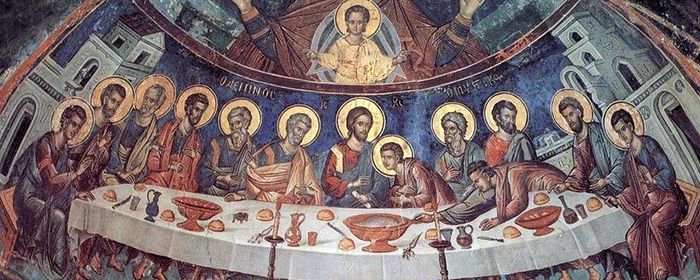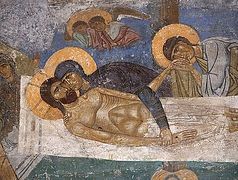Source: Orthodox Christian Network
Apirl 18, 2016
Since it was the day of Preparation, in order to prevent the bodies from remaining on the cross on the Sabbath (for that Sabbath was a high day), the Jews asked Pilate that their legs might be broken, and that they might be taken away. So the soldiers came and broke the legs of the first, and of the other who had been crucified with Him; but when they came to Jesus and saw that He was already dead, they did not break His legs. But one of the soldiers pierced His side with a spear, and at once there came out blood and water. He who saw it has borne witness—his testimony is true, and he knows that he tells the truth—that you also may believe. For these things took place that the scripture might be fulfilled, “Not a bone of Him shall be broken.” And again another scripture says, “They shall look on Him whom they have pierced.” John 19: 31-3 (From the Gospel of the Vespers on Good Friday Afternoon) Monday of the Sixth Week of Lent
We know that the Bible is divided into two parts, the Old and New Testaments. The Old Testament contains the history of God’s people—Creation, the Fall, the Law and the Prophecies of the Prophets foretelling of the coming Messiah who would save the people from their sins, from their fallen state and banishment from Paradise. The New Testament contains the earthly and salvific ministry of Jesus Christ, the establishment of the early church, and pastoral letters to the early churches.
The “prophecies” of the Old Testament are fulfilled in the person of Jesus Christ. The Crucifixion is “foretold” as far back as the Old Testament book of Exodus, with the establishment of the Passover. Most of us know that the children of Israel were enslaved in Egypt. Pharaoh was their taskmaster. God told Moses to go to Pharaoh and tell him to let the people go. Pharaoh refused. So, God, through Moses, afflicted Egypt with a series of plagues. After each plague, Pharaoh would agree to let the people go. But then his heart would harden and he would refuse.
The tenth plague was the death of the first-born son in all the Egyptian homes. The angel of death would “pass over” all the houses and kill the first-born son in each house. The people of Israel would have their children spared by placing the blood of a lamb over their doorways, and in this way, the angel would “pass over” their homes and spare their children. The blood of the lamb would be the sign that they were God’s people and would lead to the “saving” or “salvation” of their children. This “passing over” is the origin of the Jewish feast of the “Passover.”
In Exodus 12, we read about some of the details of this “Passover”:
The lamb had to be without blemish. Verse 5
The people shall eat the flesh of the lamb. Verse 8
God said, “The blood shall be a sign for you, upon the houses where you are; and when I see the blood, I will pass over you, and no plague shall fall upon you to destroy you, when I smite the land of Egypt.” Verse 13
The Passover would be a memorial day, kept forever as a feast to the Lord. Verse 14
Lambs were to be selected and killed. Verse 21
Not one bone of the Passover lamb could be broken. Verse 46
All of these preparations for the Jewish Passover prefigure the Crucifixion of Christ. And in the act of the Crucifixion and Resurrection, we receive a new “Passover.” Let’s look at a comparison of the original Passover feast with the Crucifixion:
Jesus is the “Lamb of God.” In John 1:29, John reveals Jesus by saying “Behold, the Lamb of God, who takes away the sin of the world!”
Jesus remains without blemish, without sin.
We are to partake of His flesh and blood: “He who eats My flesh and drinks My Blood abides in Me and I in Him.” (John 6:56).
The blood of Christ, both His shedding it for us, and us partaking of us, is what allows us to “pass over” from death to eternal life. It is the only way by which we can do this, the only thing that will spare us from death. We still keep Pascha (the new Passover) as a feast to the Lord.
Jesus was crucified at the same hour as the Passover Lambs in Jerusalem on Good Friday.
And not one bone of Him was broken.
Christ is called “The New Passover,” because by His blood are we saved from death.
Passover is what allowed the Egyptians to be delivered from Pharaoh. The New Passover, Pascha, the Resurrection of Christ, is what allows us to be delivered from death and to attain eternal life.
Christ, our God, Who is our Passover, is sacrificed for us; therefore let us not keep the Feast as the Judeans, but let us cleanse ourselves from every defilement, and sincerely beseech Him: “Arise, O Lord, and in Your mercy, save us.” (From the 15th Antiphon of the Service of the 12 Gospels on Holy Thursday Evening, Trans. by Fr. George Papadeas.
Prepare for your personal “Passover” today and every day.





